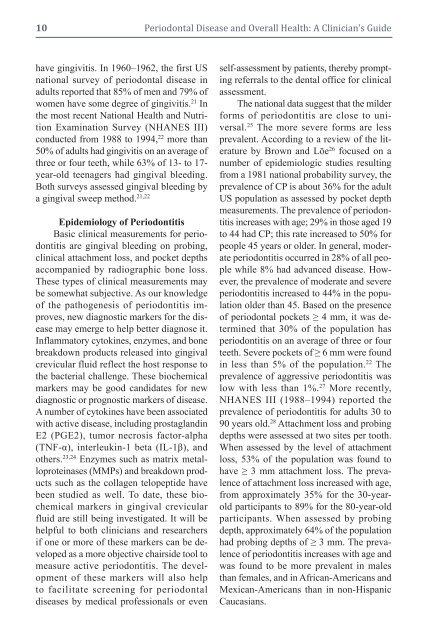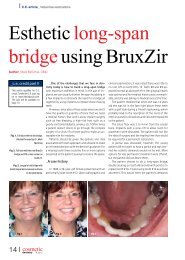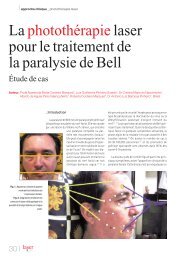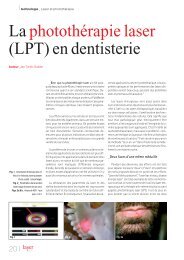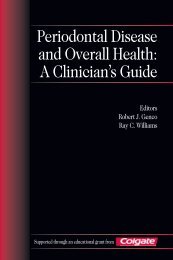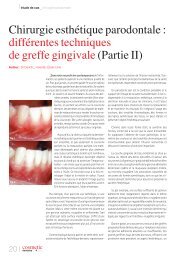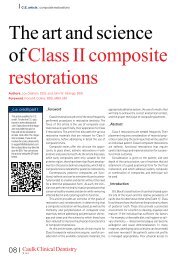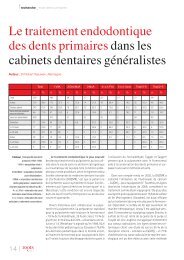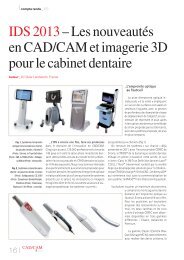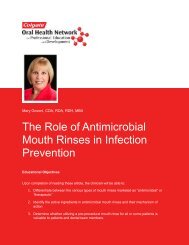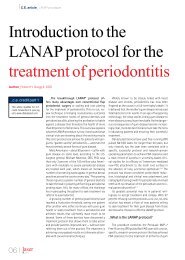Periodontal Disease and Overall Health: A Clinician's Guide
Periodontal Disease and Overall Health: A Clinician's Guide
Periodontal Disease and Overall Health: A Clinician's Guide
You also want an ePaper? Increase the reach of your titles
YUMPU automatically turns print PDFs into web optimized ePapers that Google loves.
10 <strong>Periodontal</strong> <strong>Disease</strong> <strong>and</strong> <strong>Overall</strong> <strong>Health</strong>: A <strong>Clinician's</strong> <strong>Guide</strong>have gingivitis. In 1960–1962, the first USnational survey of periodontal disease inadults reported that 85% of men <strong>and</strong> 79% ofwomen have some degree of gingivitis. 21 Inthe most recent National <strong>Health</strong> <strong>and</strong> NutritionExamination Survey (NHANES III)conducted from 1988 to 1994, 22 more than50% of adults had gingivitis on an average ofthree or four teeth, while 63% of 13- to 17-year-old teenagers had gingival bleeding.Both surveys assessed gingival bleeding bya gingival sweep method. 21,22Epidemiology of PeriodontitisBasic clinical measurements for perio -dontitis are gingival bleeding on probing,clinical attachment loss, <strong>and</strong> pocket depthsaccompanied by radiographic bone loss.These types of clinical measurements maybe somewhat subjective. As our knowledgeof the pathogenesis of periodontitis improves,new diagnostic markers for the diseasemay emerge to help better diagnose it.Inflammatory cytokines, enzymes, <strong>and</strong> bonebreakdown products released into gingivalcrevicular fluid reflect the host response tothe bacterial challenge. These biochemicalmarkers may be good c<strong>and</strong>idates for newdiagnostic or prognostic markers of disease.A number of cytokines have been asso ciatedwith active disease, including prostagl<strong>and</strong>inE2 (PGE2), tumor necrosis factor-alpha(TNF-α), interleukin-1 beta (IL-1β), <strong>and</strong>others. 23,24 Enzymes such as matrix metalloproteinases(MMPs) <strong>and</strong> breakdown productssuch as the collagen telopeptide havebeen studied as well. To date, these biochemicalmarkers in gingival crevicularfluid are still being investigated. It will behelpful to both clinicians <strong>and</strong> researchersif one or more of these markers can be developedas a more objective chairside tool tomeasure active periodontitis. The devel -opment of these markers will also helpto facilitate screening for periodontaldiseases by medical professionals or evenself- assessment by patients, thereby promptingreferrals to the dental office for clinicalassessment.The national data suggest that the milderforms of periodontitis are close to uni -versal. 25 The more severe forms are lessprevalent. According to a review of the literatureby Brown <strong>and</strong> Löe 26 focused on anumber of epidemiologic studies resultingfrom a 1981 national probability survey, theprevalence of CP is about 36% for the adultUS population as assessed by pocket depthmeasurements. The prevalence of periodontitisincreases with age; 29% in those aged 19to 44 had CP; this rate increased to 50% forpeople 45 years or older. In general, moderateperiodontitis occurred in 28% of all peoplewhile 8% had advanced disease. However,the prevalence of moderate <strong>and</strong> severeperiodontitis increased to 44% in the populationolder than 45. Based on the presenceof periodontal pockets ≥ 4 mm, it was determinedthat 30% of the population hasperiodontitis on an average of three or fourteeth. Severe pockets of ≥ 6 mm were foundin less than 5% of the population. 22 Theprevalence of aggressive periodontitis waslow with less than 1%. 27 More recently,NHANES III (1988–1994) reported theprevalence of periodontitis for adults 30 to90 years old. 28 Attachment loss <strong>and</strong> probingdepths were assessed at two sites per tooth.When assessed by the level of attachmentloss, 53% of the population was found tohave ≥ 3 mm attachment loss. The prevalenceof attachment loss increased with age,from approximately 35% for the 30-yearoldparticipants to 89% for the 80-year-oldparticipants. When assessed by probingdepth, approximately 64% of the populationhad probing depths of ≥ 3 mm. The prevalenceof periodontitis increases with age <strong>and</strong>was found to be more prevalent in malesthan females, <strong>and</strong> in African-Americans <strong>and</strong>Mexican-Americans than in non-HispanicCaucasians.


